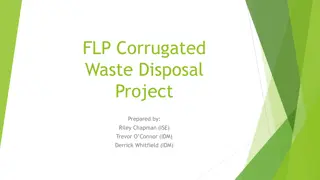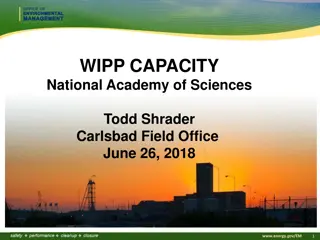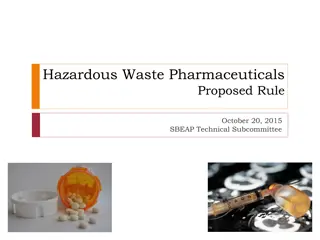Challenges in Waste Management and Disposal: A Critical Overview
Managing waste disposal poses significant challenges globally, with issues ranging from solid waste in limited landfills to liquid waste polluting waterways. Despite increased awareness, per capita waste production continues to rise, necessitating sustainable solutions to minimize negative impacts on the environment and community liveability.
Download Presentation

Please find below an Image/Link to download the presentation.
The content on the website is provided AS IS for your information and personal use only. It may not be sold, licensed, or shared on other websites without obtaining consent from the author. Download presentation by click this link. If you encounter any issues during the download, it is possible that the publisher has removed the file from their server.
E N D
Presentation Transcript
Key waste disposal issues As levels of waste in a community increase the amenity (or liveability) of that community declines. Waste therefore needs to be disposed of in ways which minimise its negative impacts. Much of the waste humans produce is not bio- degradable (or decomposable).
Even with increased public awareness of waste issues and a greater level of general recycling, Australia's level of per capita waste production is not declining. Household waste generation in Perth, for example, grew by approximately 30 per cent between 1998 and 2002. Australia's major waste disposal issues are outlined below.
Solid waste and limited landfills Disposing of solid waste, such as household garbage and industrial by-products, has traditionally involved dumping it in a landfill (commonly referred to as a 'tip'). The use of landfills as a waste disposal method does, however, present a number of environmental management problems. Finding new and appropriate landfill sites is becoming much more difficult and the concept of a landfill itself is not sustainable, as it will not last forever.
Liquid waste and polluted waterways Sewage effluent (run-off) and other household waste that is produced, for example, by dishwashing and car washing detergents, are all categorised as liquid waste. Liquid waste is also produced by industrial processes and can include toxic chemicals.
Most liquid wastewater is disposed of in coastal regions and only about one per cent is recycled. Proposals to introduce domestic wastewater recycling systems to service urban areas are currently receiving much more attention in Australia, as the problems of liquid waste disposal and availability of drinking water supplies are simultaneously presenting concerns for residents in many parts of the country.
Solid waste is also another contributing factor to polluted waterways. Around six billion tonnes of waste is discarded into oceans around the world each year. The majority of this rubbish is some form of plastic matter.
Common examples are shopping bags, drink bottles, fishing equipment and polystyrene materials (such as tea and coffee cups). The amount of plastic waste found in our oceans poses a major threat to marine wildlife. Many species can suffocate and die if they consume plastic or become entangled in other forms of debris dumped at sea, such as abandoned fishing nets.
Gaseous waste and air pollution Our increasing levels of energy consumption have also resulted in higher levels of atmospheric waste, mainly in the form of harmful greenhouse gases. Although this type of waste may not be as visible as solid or liquid waste, air pollutants pose no less threat to humans.
Australia does not boast a good track record when it comes to greenhouse gas emissions, which is mainly due to the fact that coal, oil and natural gas are our three major sources of energy. All of these naturally occurring non-renewable resources are contributors to the greenhouse effect and global warming.
Hazardous waste Sometimes referred to as 'toxic waste', hazardous waste is that which requires special handling when being disposed of because of the threat it poses to humans and the environment. Nuclear waste is an example of hazardous waste.
Much of the controversy surrounding the use of nuclear energy has arisen because there is still no known effective way of disposing of the radioactive waste generated. Mismanagement of this type of waste can be detrimental to living organisms.
Thinking about waste A factor contributing to Australia's waste problem is the way in which we conceptualise (think about) rubbish and our established patterns of production and consumption, which are presently unsustainable. A dominant mentality has emerged that waste does not really affect us, as long as it can be hidden away in a landfill or washed down the drain.
Adopting a more considered (or more conscious) attitude towards the waste we produce and what is done with it is essential. Not only will a change in waste disposal methods improve our environment aesthetically, it will also help to restore biodiversity and improve the quality of our land, air and water.
Sustainable waste management initiatives Questions surrounding the issue of waste disposal have traditionally received a great deal of attention. It is becoming more apparent, however, that the focus needs to be on the more sustainable goals of waste minimisation and waste recovery - reducing, reusing and recycling our waste.
These goals are much more in line with the principles of ecological sustainability and have the potential to significantly reduce human impact on the environment. Most people are familiar with the concept of recycling when it comes to household items such as paper, plastic bottles and food scraps. Another example of recycling on a larger scale, which is starting to receive more attention in Australia, is the concept of recycling wastewater.
In July 2006, residents of Toowoomba in Queensland cast their vote on a new proposal which would have seen 25 per cent of the town's water sourced from recycled sewage. Although in this case a little over 60 per cent of the electorate voted 'no' to the environmentally-friendly plan, proposals such as this (already operating in other countries) are starting to receive more consideration, particularly in areas of Australia where the provision of potable drinking water has become a major problem. http://www.abc.net.au/catalyst/stories/2514066.htm























